You will love this classic recipe for Persimmon Jam, made with sweet, ripe fruit at the height of the season. It is the ultimate way to preserve this vibrantly coloured autumnal fruit to enjoy throughout the months ahead. To make this jam, you will use only four ingredients: fresh Persimmon, water, sugar and lemon juice - no additional pectin is required.
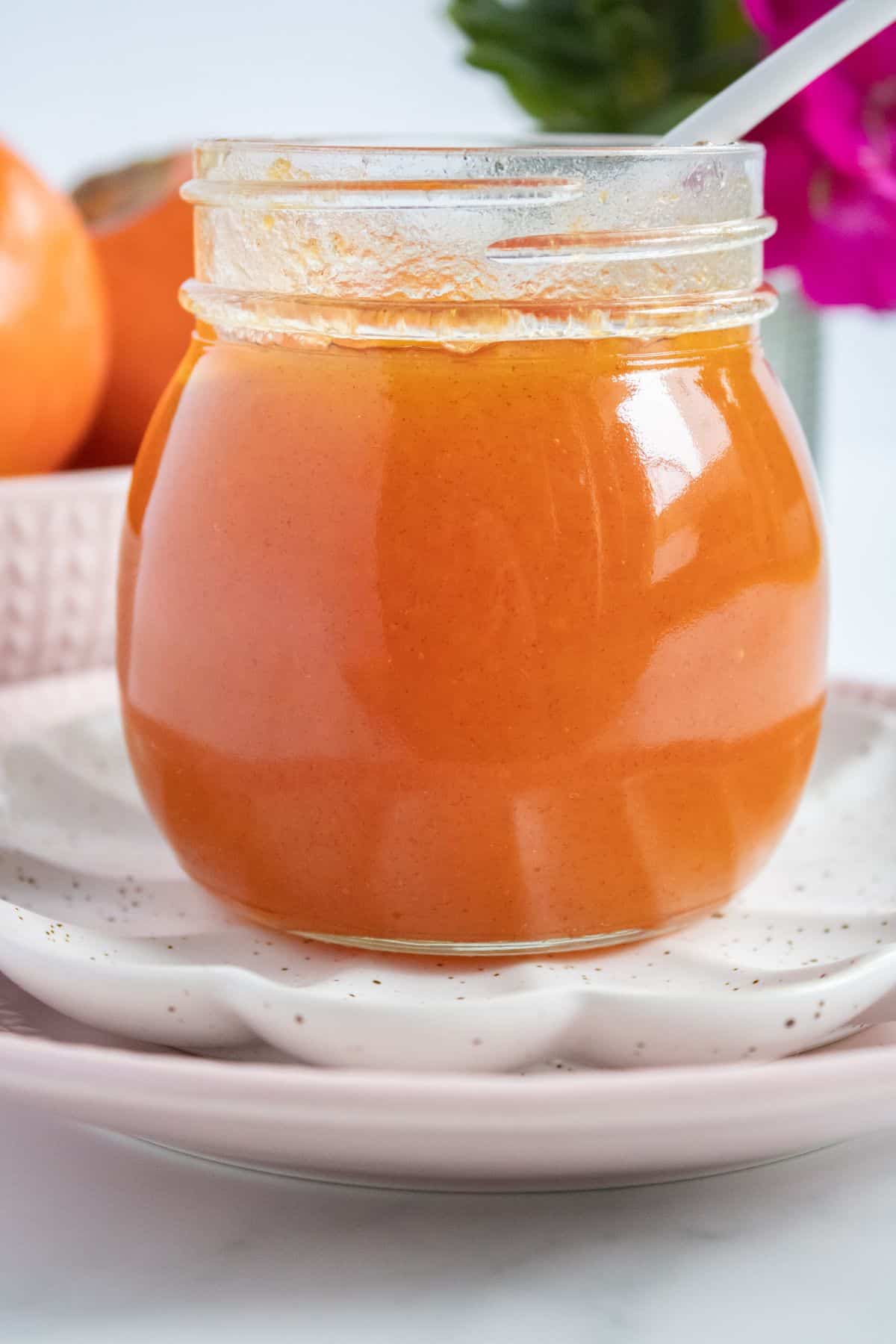
Why you'll love this recipe:
Persimmon Jam is incredibly easy to make, and having a few jars of this condiment in your store cupboard means that you will be able to enjoy one of the delights of autumn far beyond the season.
You will just need to invest a little of your time - when you finish and see your own produce lined up, you will know that it was time well spent.
You will love this recipe for Persimmon Jam because:
- It is made from just four ingredients, using Persimmon at the height of the season.
- This is a great way to use some of autumn's bounty to enjoy in the months ahead.
- Homemade jam is infinitely superior to shop bought. There are no unwelcome additives, artificial preservatives, or thickeners that you may find in a commercially prepared jam. To me, one of the most important aspects of making your own jam is knowing that you control the quality of the ingredients.
- There are many ways to use this delicious jam, some of which we suggest below.
- You will not need any special equipment to make this recipe. Just a large, wide, non-reactive saucepan and a long-handled wooden spoon to keep your hand away from the boiling jam. Non-reactive saucepans are those which are ceramic, stainless steel, glass or enamelled cookware. Copper, iron and aluminium pans are reactive. Acidic foods, such as lemon juice, may cause the jam to take on a metallic taste and discolour if cooked in such pans.
Ingredients in this recipe:
Please see the recipe card further along in the post for exact quantities of ingredients and the full method.
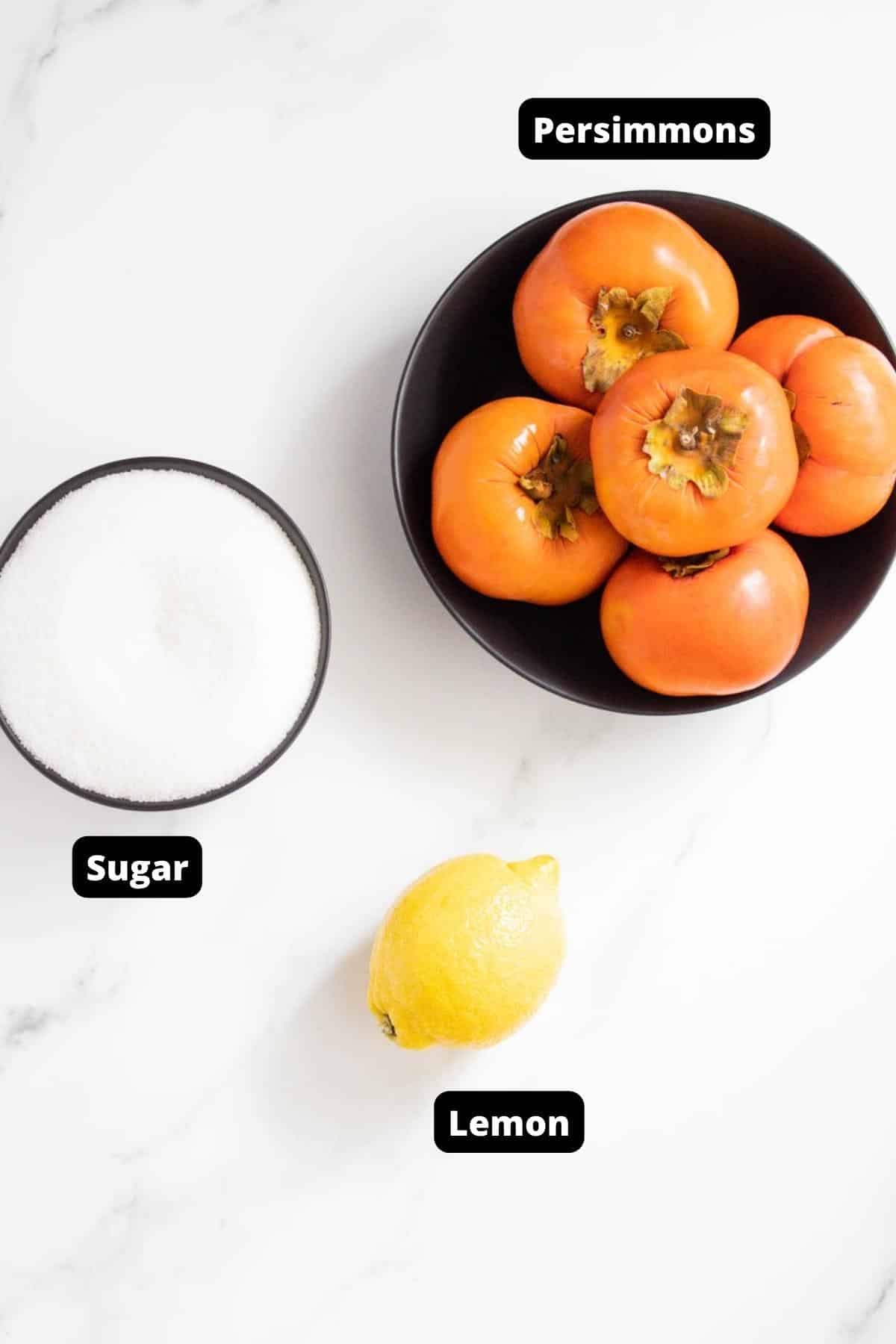
Persimmon - a native of China, Wikipedia advises that this vibrantly coloured, orange fruit was first cultivated more than 2,000 years ago and introduced to Japan in the 7th century. Whilst there are many varieties, there are two main sub-species, astringent or non-astringent. For the jam, we use the non-astringent Japanese variety, Fuyu. This variety is round and squat, vaguely resembling a tomato. This is an extremely versatile fruit; they can be eaten hard or soft, with the skin removed or left on. As well, they can be incorporated into sweet or savoury dishes, used raw or cooked. They don't have a central core, although you may find an occasional seed which you will need to remove. Persimmons are naturally high in pectin which aids with the jam reaching setting point
Lemon juice - lemon juice has two important functions in jam making. Firstly, lemon juice is acidic, and acids are important in helping the jam to set. Also, the acidity of the lemon juice helps with preservation and balances the sweetness of the sugar.
Sugar - sugar is vital to flavour the jam by sweetening it. Also, it interacts with the acids and pectin, helping the jam to set. Additionally, it has a preservative effect enabling the jam to be shelf-stable to enjoy through the months ahead.
Water - we use a small amount of filtered water. This aids in softening the fruit before the sugar is added.
How To Make Persimmon Jam:
Please see the recipe card further along in the post for exact quantities of ingredients and the full method.
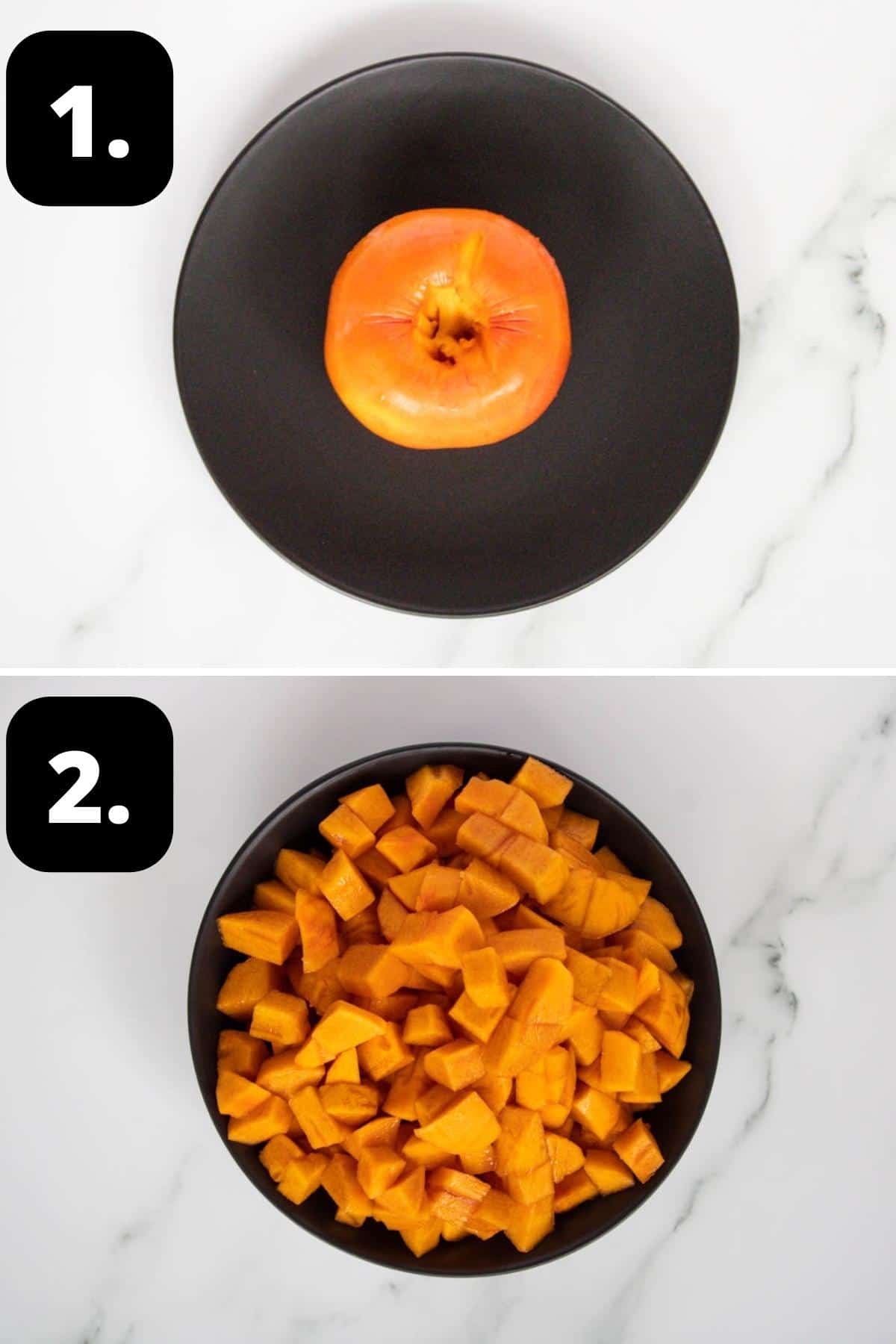
1 - Remove the stem:
Wash and dry the persimmon. Cut out the stem and remove the skin.
2 - Cut the Persimmon into small cubes:
Cut the flesh into dice about 1 cm (⅖ inch) and add to a large, wide saucepan, along with a small amount of water.

3 - Cook the fruit:
Over medium heat, bring it to a gentle simmer, stirring frequently to ensure the fruit doesn't stick.
4 - Add the sugar:
After about 10 minutes, when the fruit softens, add the lemon juice and sugar. Stir frequently to dissolve the sugar.
When the sugar dissolves, increase the heat and bring the mixture to a rapid boil. Stir frequently to prevent the jam from catching on the bottom of the pan.
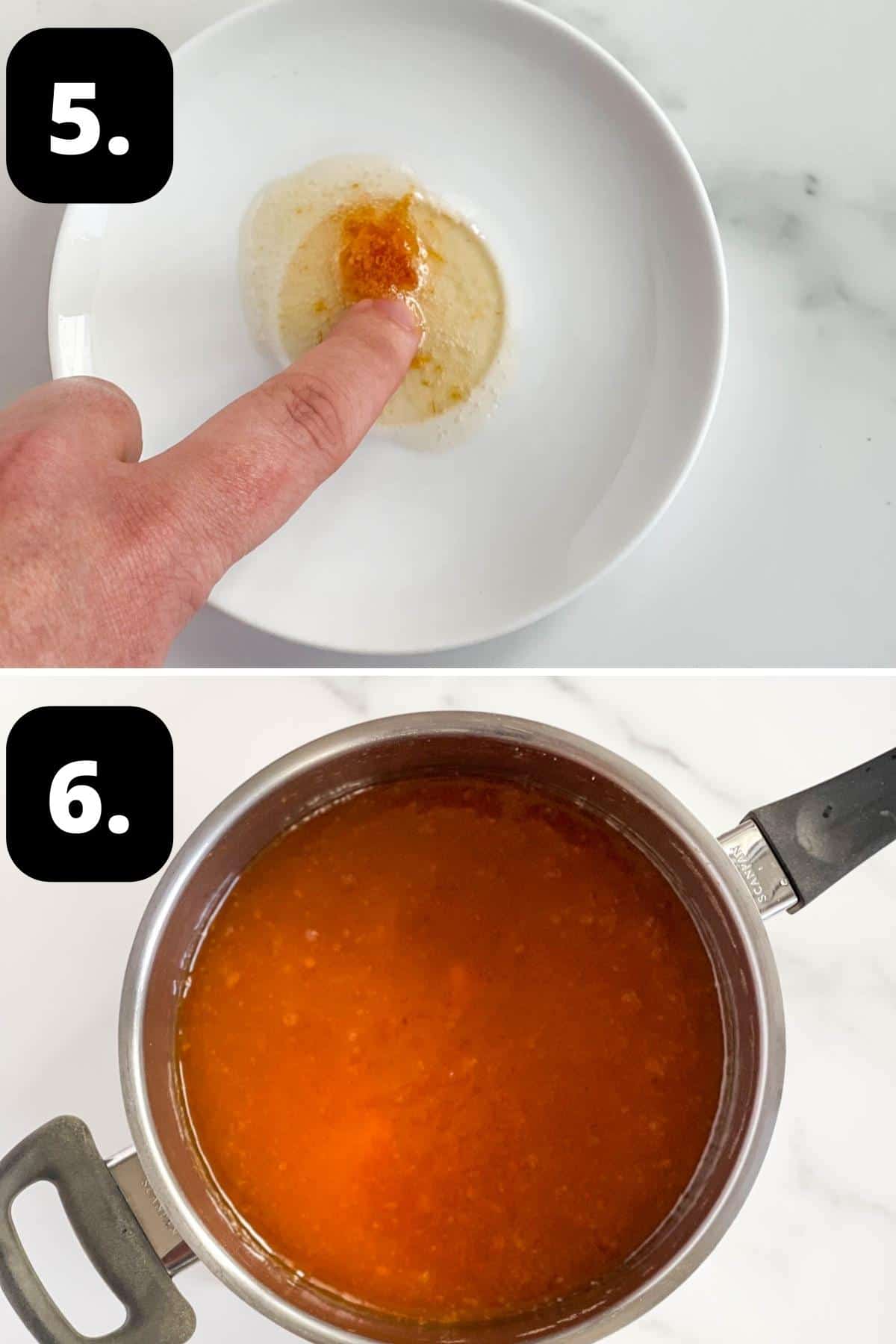
5 - Test the Jam:
After about 12 minutes, test for setting point. I use the "wrinkle" test. More details are in the recipe below. You can also use a jam thermometer to check for setting point, which is 105 degrees C (220 F).
6 - Bottle the Persimmon Jam:
If you like a jam with pieces of fruit, set the saucepan aside for about 5 minutes to allow the fruit to be evenly distributed throughout the jam. If you prefer a smooth jam, use an immersion blender to blend the mixture.
Ladle the jam into the hot, sterilised jars and seal immediately.
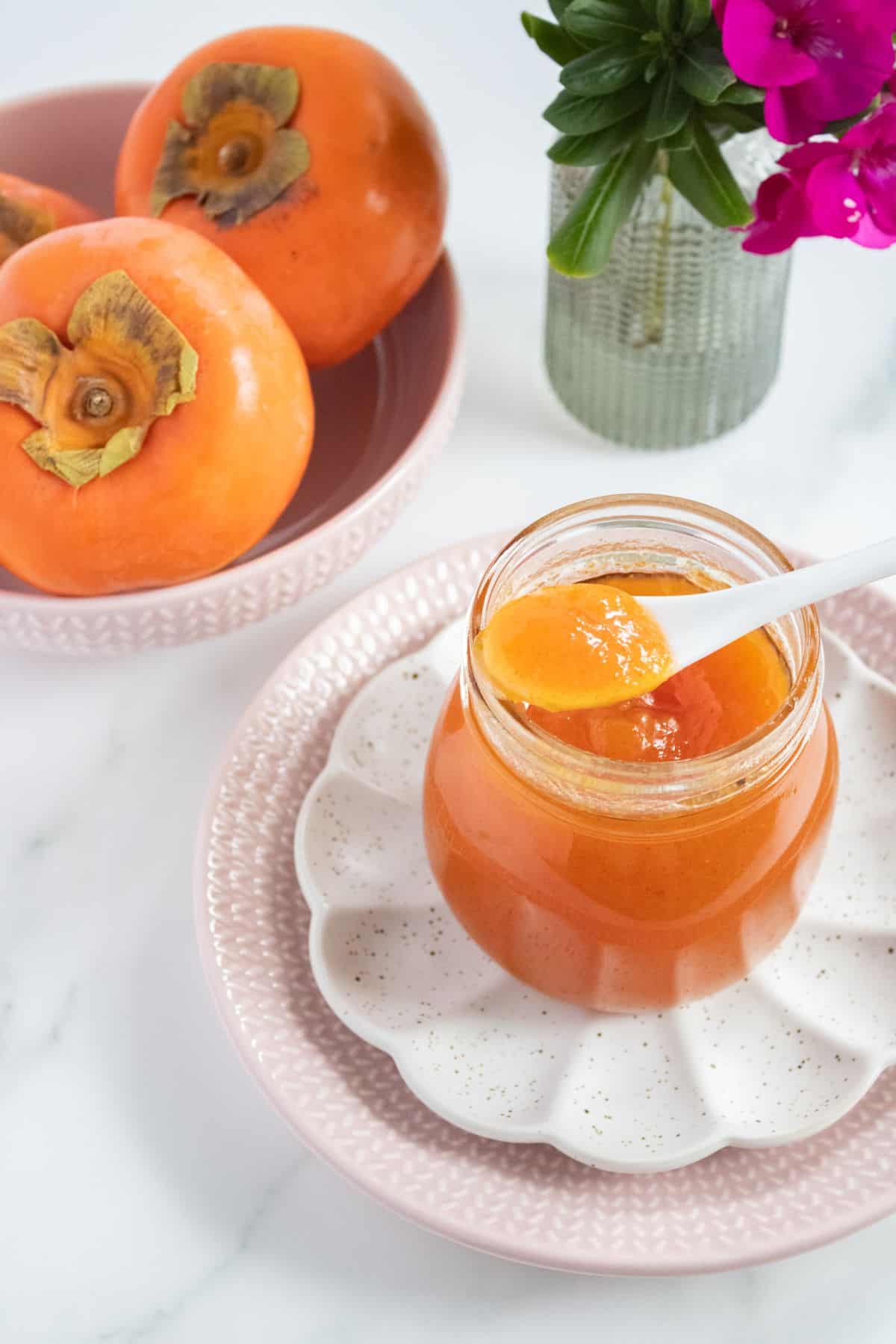
Tips for success and FAQs:
For the best result, choose good quality, freshly picked fruit. The persimmons should feel firm and heavy for their size. Avoid any that are over-ripe or bruised, as they may cause the jam to spoil. However, if you have some that are slightly unripe, don't hesitate to use them. They also assist with setting as they contain more pectin.
When making your own jams and preserves, always ensure you sterilise the jars you will store them in. This is very simple to do, and I have given full details in the recipe. As well, I recommend that you use a jar with a wide opening to make it easier to fill with the hot jam.
Pectin is a naturally occurring starch that is found in varying degrees in fruits and vegetables. It is what makes jams and jellies firm when they are cool. When combined with acid and sugar, and cooked to a high temperature, it forms a gel. In this recipe, I add a small amount of lemon juice to boost the pectin and acid content.
If you follow the recipe instructions precisely and your jars are thoroughly sterilised, the Persimmon Jam will be shelf-stable for 12 months. No canning is required. When you open a jar, store it in the fridge. Always use a clean spoon to remove the jam.
Yes, you can eat the whole fruit. However, we have removed it to make the jam smoother.
Conventional jam requires a lot of sugar. When you see it weighed out it is slightly alarming but please don't reduce the amount of sugar. The sugar not only sweetens the fruit, but it helps the jam to set and acts as a preservative. If you reduce the sugar, your jam may not be shelf stable.
Lemon plays an important role in jam-making. It is high in acid and pectin, both essential for the setting of the jam. As well, the acidity of the lemon helps balance the sweetness.
Variations and substitutions:
Lemon juice - if you prefer, lime juice is a good substitute.
Spices - a little ground cinnamon and star anise are a delicious addition, if you prefer to add a little extra flavour to your jams.
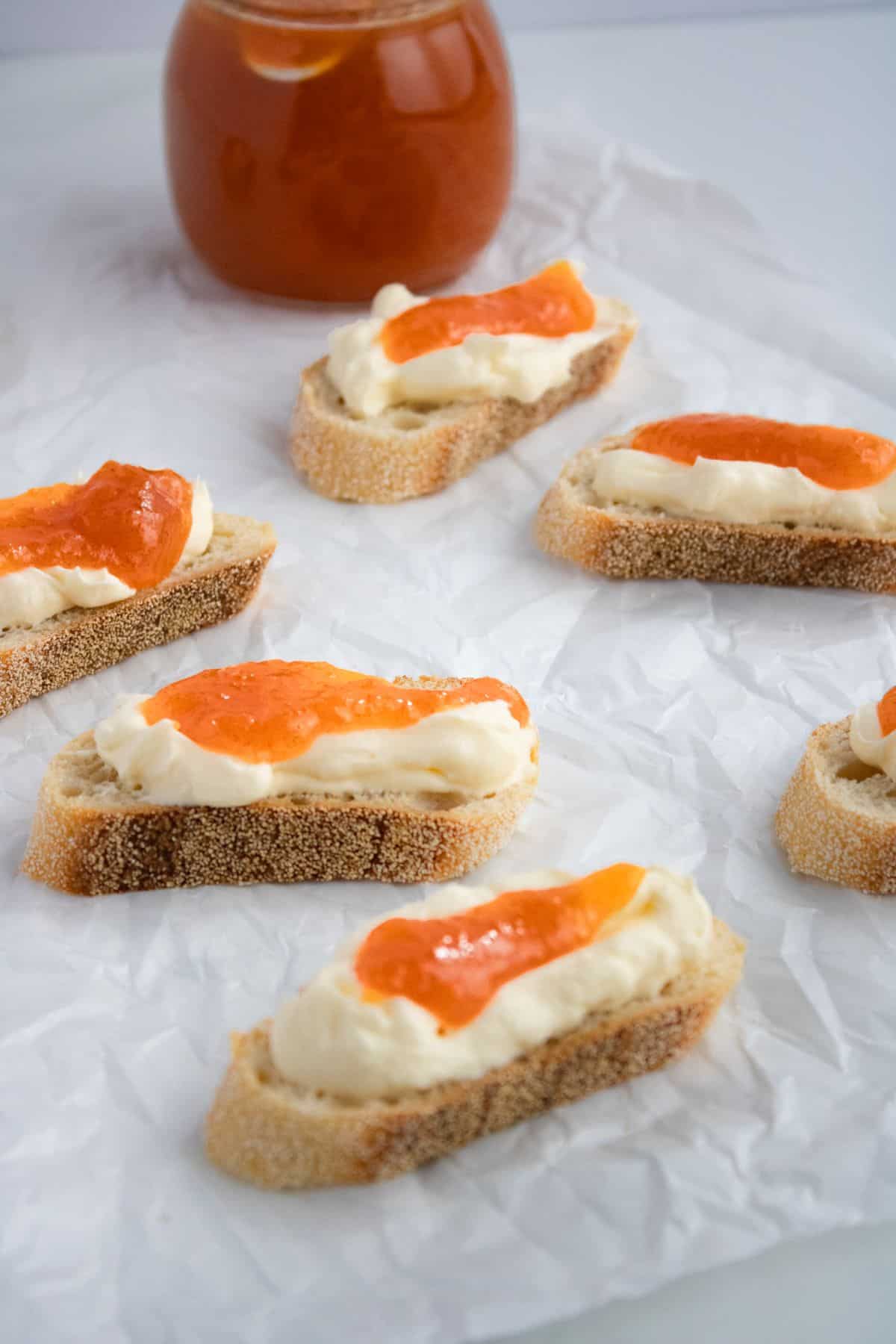
Serving suggestions:
There are many ways to enjoy this delicious jam, in either sweet or savoury applications. Some suggestions are:
- Served with scones and cream.
- Spooned onto plain Greek yoghurt.
- With toast for breakfast - I love it on our Spelt Bread Loaf.
- Add to a cheese board; it is delicious with a soft cheese, such as Camembert.
- Served with our Oat Flour Pancakes or Waffles.
- On top of porridge.
- To glaze a ham.
- Use in our Jam Oatmeal Bars.
I believe that homemade jam is a special treat. What's more, this homemade Persimmon Jam is the perfect way to use fruit at the peak of its season. Aside from being simple to make, perhaps the best reason is that it tastes so much better than store-bought jam.
Alex xx
More delicious recipes for you to try:
Stay in touch!
Follow me on Facebook, Pinterest and Instagram and subscribe to my newsletter.
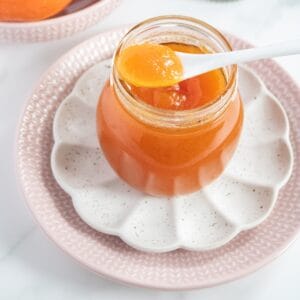
Persimmon Jam
Equipment
- 4 x 300 ml (10 fluid oz) Jars
Please note:
For accuracy, when weights are provided, we recommend weighing your ingredients. This will produce the best results. All oven temperatures listed are for fan forced.
Ingredients
- 1 kg (35 oz) Fuyu Persimmons - prepared weight See Note 1
- ⅓ cup (80 ml) water
- 3 ⅓ cups (755 gm) sugar See Note 2
- ¼ cup (60 ml) lemon juice See Note 3
Instructions
Sterilising the Jars:
- Sterilise the jar or jars you'll be using to store the jam. Choose glass jars with an airtight, metal lid and ensure they have been washed by hand in hot soapy water then rinsed well. Check that the metal lids do not have rubber inserts – if they do, allow them to air dry, instead of placing in the oven. Preheat the oven to 130 Degrees C (270 F) and place the jars in the oven for 15-20 minutes. Keep the jars warm.
For the Persimmon Jam:
- Place two small saucers or plates in the freezer. (See Note 5.)
- Wash and dry your fruit. Remove the stem from the fruit and peel the Persimmon.
- Cut the fruit in half and then half again. Remove any seeds and blemishes. Roughly chop the fruit into 1 cm (½ inch) cubes.
- Add the Persimmon cubes and water to a large saucepan over a medium-low heat. Stir frequently for 10 minutes, using a long-handled wooden spoon, to ensure the fruit doesn't stick. (See Notes 6 and 7.)
- Add the sugar and lemon juice to the saucepan. Stir until the sugar dissolves - this will take 3-5 minutes.If sugar crystals get caught on the side of the saucepan, scrape down with a spatula.
- Once the sugar has dissolved, increase the heat to a rolling boil.Boil for 12 minutes, stirring frequently. After 12 minutes, begin to check for the setting point. Your jam will likely take between 12-18 minutes, but it will depend on the width of your saucepan and how rapidly the jam is boiling.
- Turn off the heat and spoon a little of the jam onto one of your chilled saucers.Let it stand for 30 seconds to cool, and then run your finger through it. If it wrinkles, even slightly, it is ready. If it is still quite liquid, put it back on the heat and boil for a further 1-2 minutes, and retest until ready. Alternatively, you could use a candy thermometer. Setting point is reached when the thermometer reaches 105 Degrees C (220 F).
- Skim any scum off the top of the jam with a spoon.
- Either leave the jam to stand for five minutes to allow the fruit to disperse evenly, or use an immersion blender to carefully blend the fruit to your desired consistency. (The photos show the jam pureed.)
- Carefully ladle your jam into your hot jars and put the lids on immediately. Allow the jam to cool completely. Wipe the jars to remove any spills, and store the jam in a cool, dark place.
Notes
- Persimmons: we use Fuyu for this recipe. Ensure your fruit is freshly picked and of good quality. Avoid fruit that is bruised or over-ripe. The persimmons contain pectin, which aids in the jam setting. If your fruit is older, it will contain less pectin.
- Sugar: do not reduce the amount of sugar. Whilst the sugar sweetens the fruit, it also acts as a preservative and helps the jam to set. If you reduce the sugar, your jam may not be shelf-stable and may become mouldy.
- Lemon juice: not only balances the sweetness of the sugar, but it also contains acid and pectin, which help to set the jam.
- Sterilising the jars: properly sterilising your jars is an essential process to remove bacteria that could cause your preserves to spoil.
- Chilled plates: we use the chilled plates to quickly cool the jam when testing the setting point.
- Saucepan: I choose a large, wide saucepan that has enough height to enable the jam to boil vigorously. More surface area means the liquid will evaporate faster; having sufficient height means you can boil the jam at a higher heat and maintain the fresh flavour of the persimmons. Avoid aluminium, copper or iron pans; the acid in the fruit may react with the pan, giving the jam a metallic taste.
- Wooden spoon: do not use a metal spoon - it will become very hot. A long-handled wooden spoon is important to avoid being burnt by a splash from boiling jam.
- Setting point: my jam reached its setting point about 15 minutes after it began to boil rapidly. Boiling time will vary depending on the size of your saucepan and the heat that you apply.
- Immersion blender: if you prefer smooth jam, carefully use an immersion blender, once you have taken the Persimmon Jam off the heat. The photos show the blended jam.
- Storage: when the recipe is made according to instructions and the jars have been sterilised properly, the jam will be shelf-stable for up to a year when stored in a cool, dark place. A jar should be refrigerated after opening. This recipe has not been tested using a canning method. Please refer to the USDA Canning Guidelines for techniques, or follow a recipe designed for long-term canning.
- Nutritional information: is based on one whole jar. The nutritional information is an estimate only.
Nutrition Estimate:
Nutritional Disclaimer:
The nutritional information is an estimate only, and is derived from online calculators. For accurate results, we recommend calculating the nutritional information based on the ingredients and brands you use.





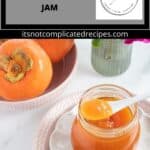
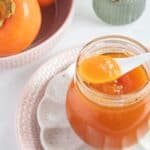
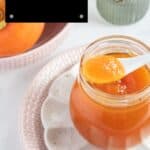



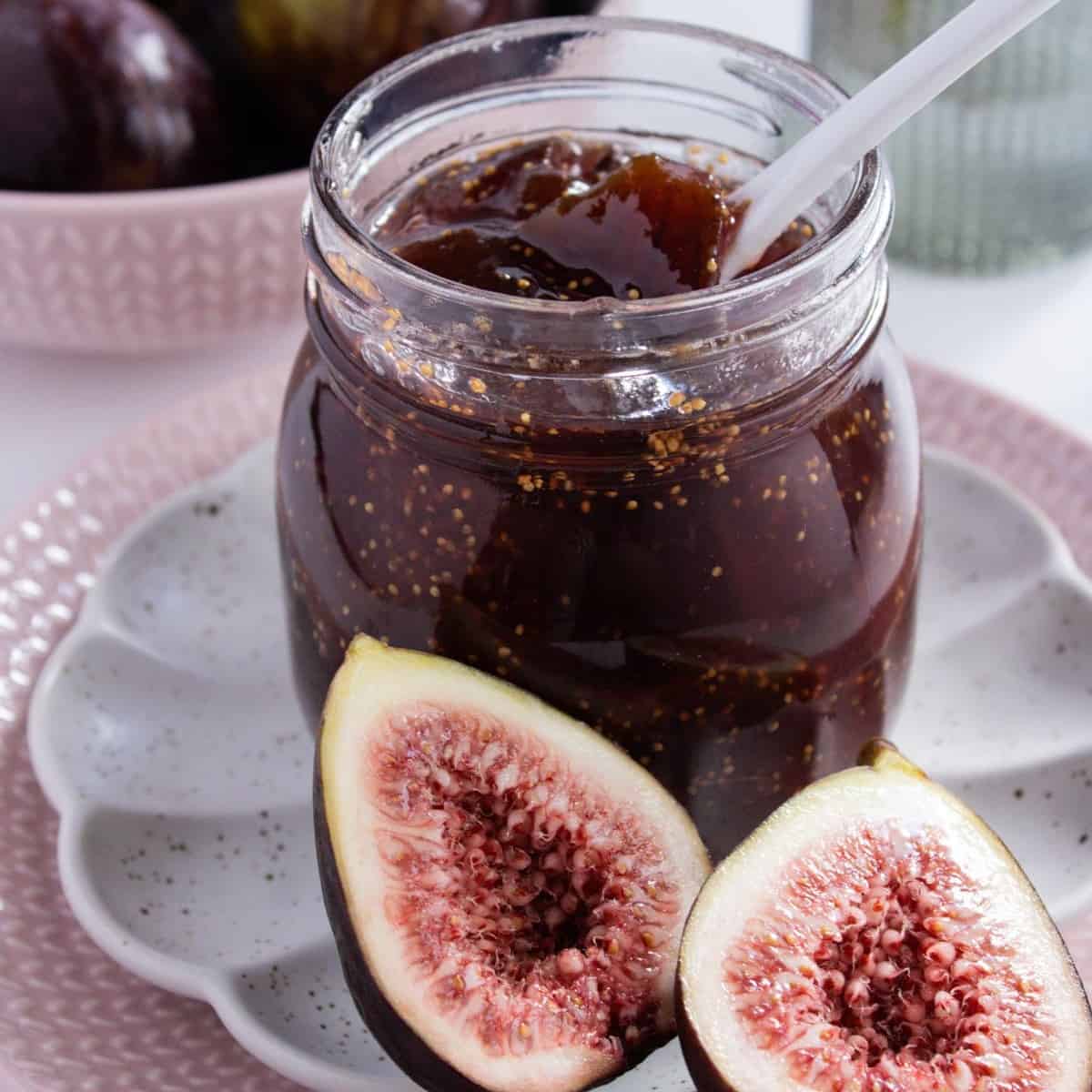
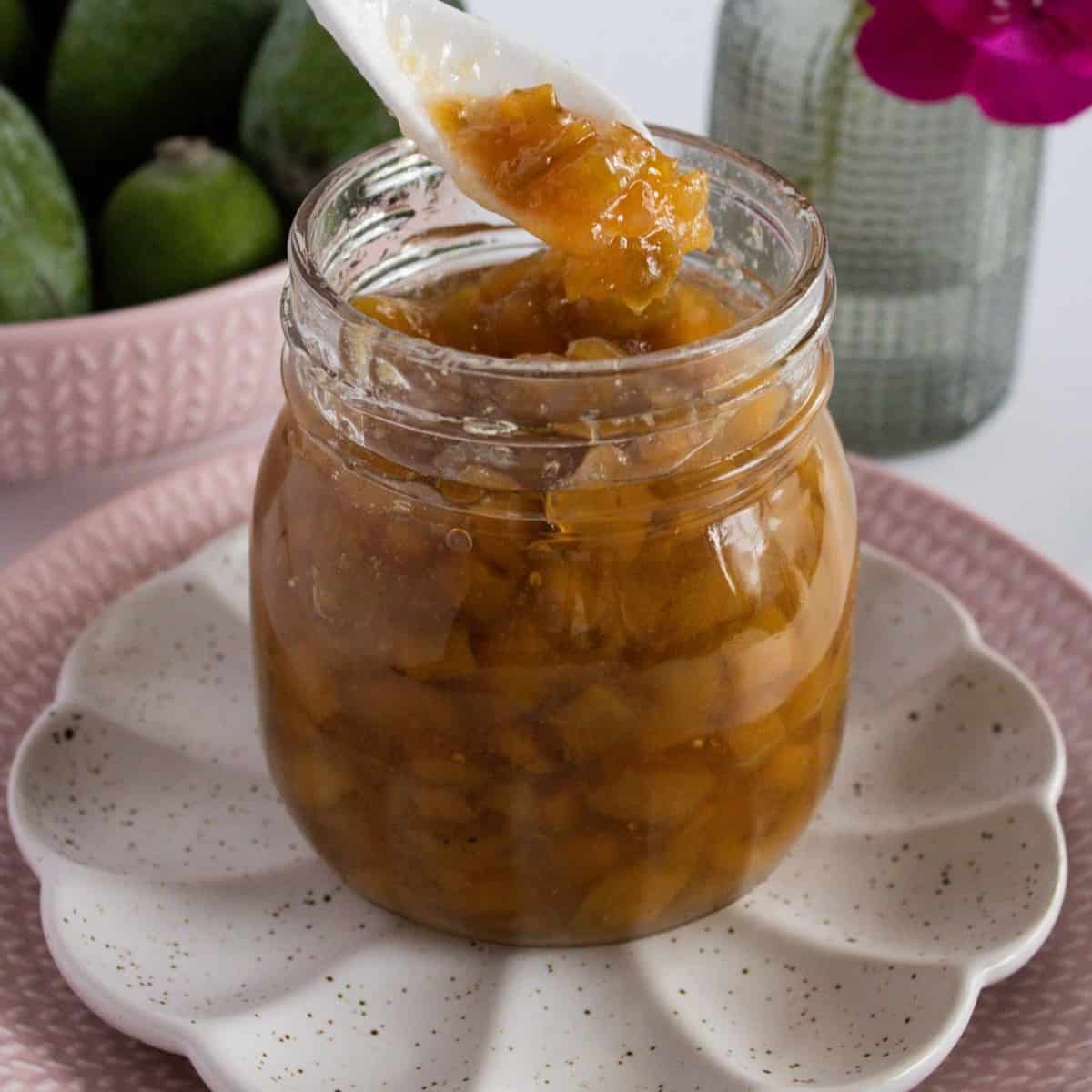
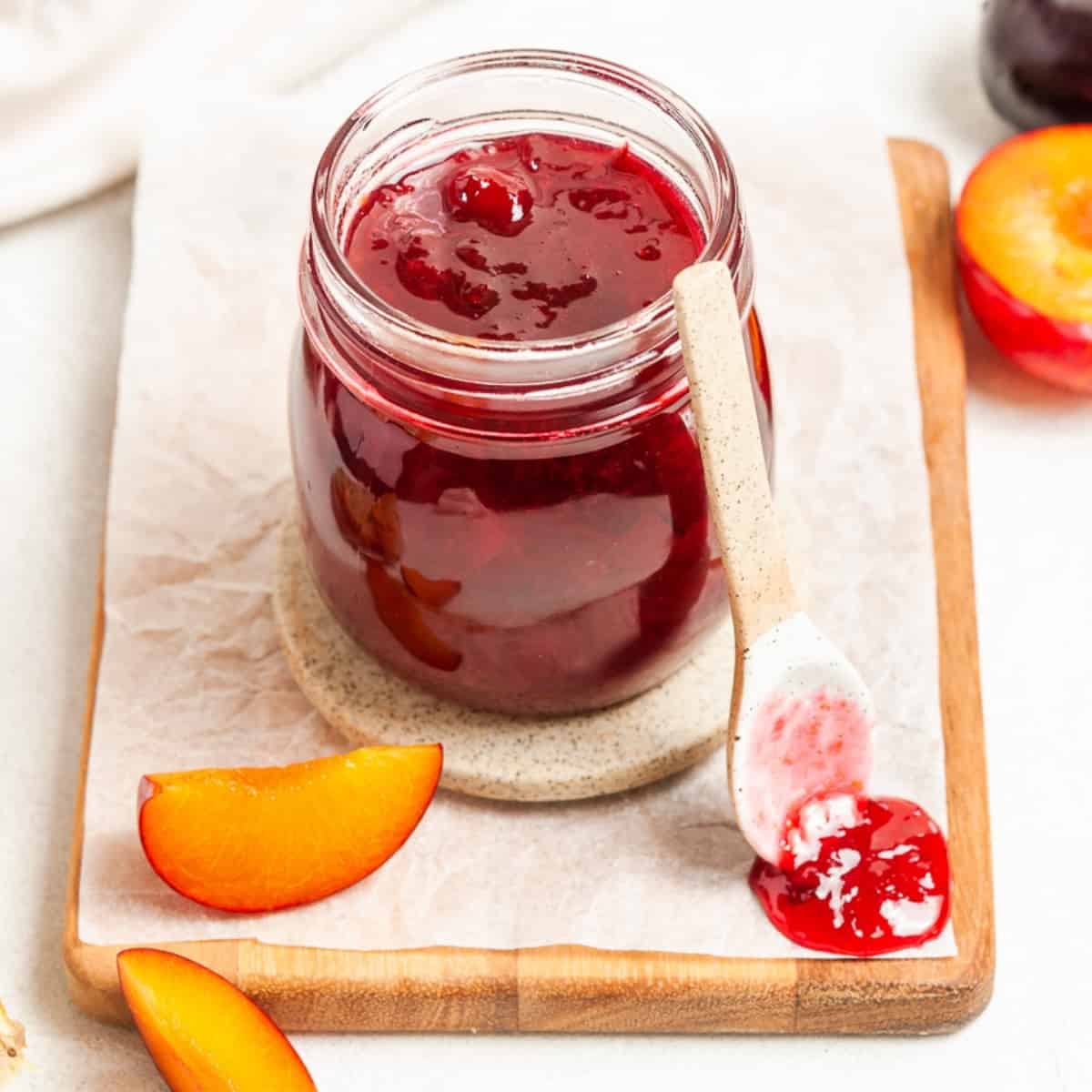
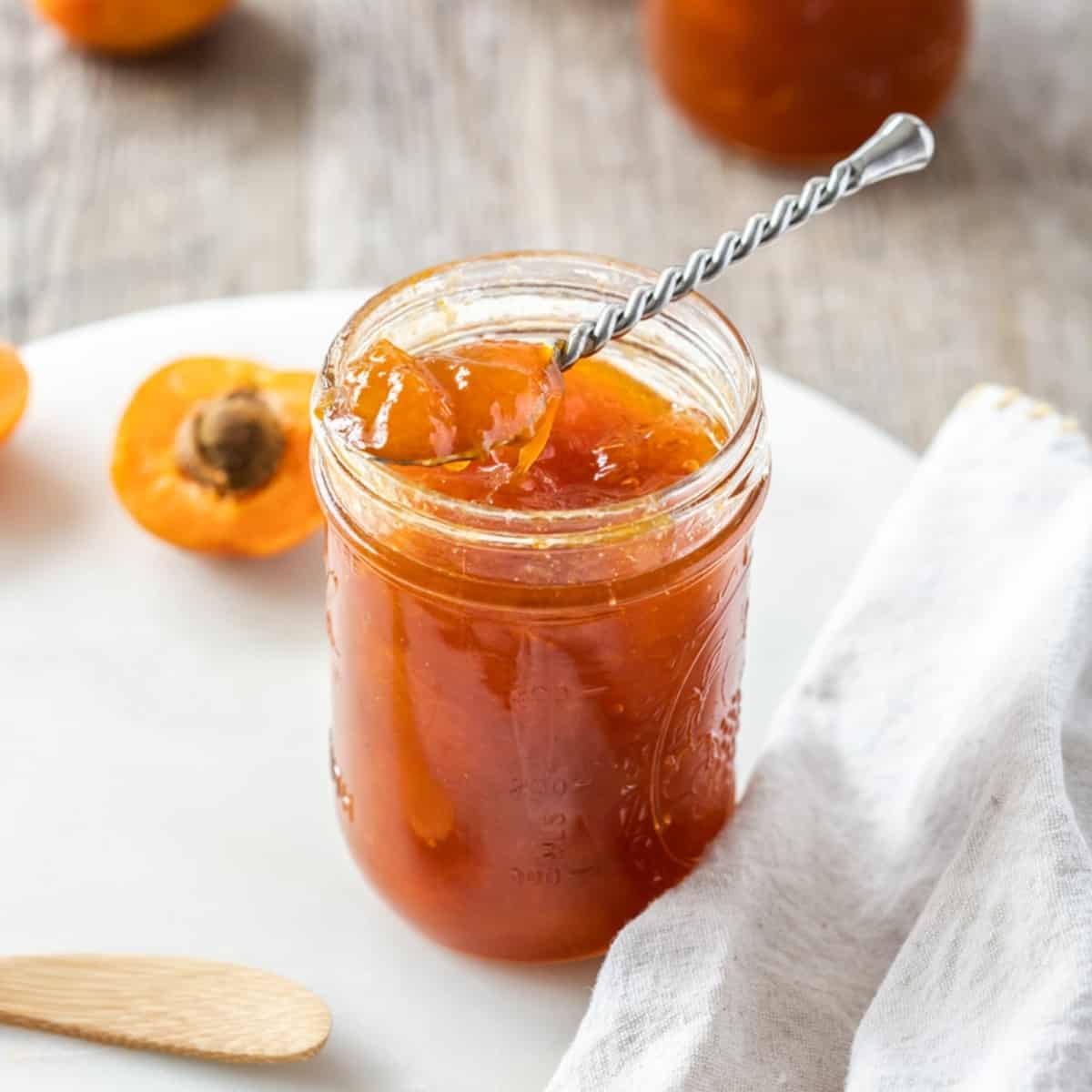
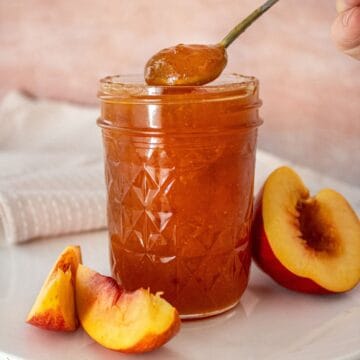
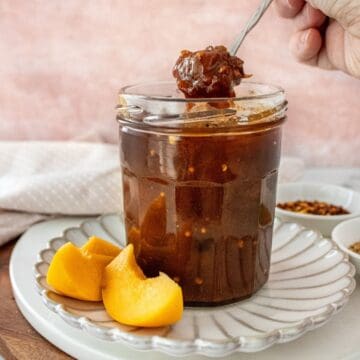

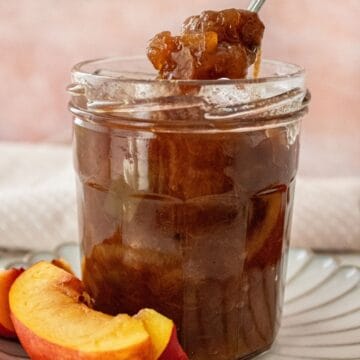
beverly says
I just picked the first fruit from our trees over the weekend - just a small batch, so this recipe was ideal. I'll definitely be using this recipe again for future jam making projects.
Alexandra Cook says
Hello Beverly,
Thank you so much for trying our recipe, and I am so pleased you'll be using it again!
How lovely to have your own persimmon trees.
Appreciate your comment! Alex xo
Buford Morton says
I made 3 batches
the taste is great.
thanks for great and easy recipe.
Alexandra Cook says
Thank you so much for trying this recipe 🙂
Enjoy your jam! Alex xo
j says
You really really need to water bath can these to make them safe to store on a shelf. Really.
Otherwise store in the refrigerator.
Alexandra Cook says
Hello J,
Thank you for reaching out 🙂
For the jam, I follow the method that my great grandma used – the hot sterilised jars and the hot jam with the lids put on immediately cause a vacuum to form a seal as they cool. As the jam has just been vigorously boiled, we don’t boil it again in a water bath. The jars are shelf-stable for 12 months, and only need to be refrigerated once they have been open.
This is a method most commonly used in Australia/UK, although I am aware that in the USA/Canada water bath canning is the more popular method.
If you prefer to water bath, you certainly can, and you can find more information here.
Jam can also be frozen too for up to 6 months – just be sure to leave a small gap in each jar as it will expand when frozen.
Alex xo
Patricia Conner says
That’s what I’m doing…water Bath
Carlo Mazzella says
very easy to follow.
thank you.
Alexandra Cook says
Thank you, Carlo! 🙂
Bernice says
Absolutely stunning jam and the recipe was perfect. I've always wanted to explore working with persimmons a bit more and was inspired by this post!! Can't wait to gift jars to friends and family at Christmas.
Alexandra Cook says
Hey Bernice!
The jam will make such a lovely Christmas gift 🙂
Thanks so much for sharing, Alex xo
Stacey says
Planning to try this persimmon jam recipe as my Fuyu persimmon tree is still loaded, even after baking many persimmon cakes and muffins, and giving away pounds of them to friends and neighbors. But I'm wondering how it can be shelf stable without canning? I've never done any canning, although I would like to. I've only made freezer jams, and assume this would freeze well also?
Alexandra Cook says
Hi Stacey!
How lovely to have a persimmon tree! 🙂
We follow the method used by our ancestors – the hot sterilised jars and the hot jam with the lids put on immediately cause a vacuum to form a seal as they cool. As the jam has just been boiled, we don’t boil it again in a water bath. The jam is shelf-stable for 12 months.
This is a method most commonly used in Australia/UK, although I am aware that in the USA/Canada water bath canning is the more popular method.
If you prefer to water bath, you certainly can, and you kind find more information here.
You can freeze the jam for 6 months - if you plan on doing this, leave a slight space in the jar as the jam will expand as it freezes.
Hope that helps, Alex xo
Stacey says
Thank you so much for your reply. Definitely will try it this week. Just harvested about 60 pounds of persimmons... and still more on the tree. 🙂
Alexandra Cook says
Wow! 🙂 That is amazing. Happy jam making! xo
Pat says
I’ve made jams for nearly 60 years and never canned any of it. If it is boiled to the correct temperature, have your sugar and acid quantiles correct, and seal the washed, dried and warmed jars as soon as you put the jam in, a seal is made, the jams last for a long time perfectly.
Mark says
This is a great recipe! The jam is fabulous! We’ve made two double batches of the jam with great results. One challenge we had was figuring out the “wrinkle” test. We didn’t have a thermometer, either. So, we guessed. And the result was grand. We were grateful for the fruit-laden Persimmon tree in the backyard. The pricing of the fruit in the grocery stores makes this an expensive effort.
Alexandra Cook says
Hello Mark!
Thank you so much for giving our recipe a try - I am so happy you enjoyed it.
How lovely to have a Persimmon tree in the backyard 🙂
Enjoy your jam! Alex xo
Marina says
Thank you for sharing this amazing recipe of Persimmon Jam, I have just finished making it (so easy!) and cannot wait to try it. My daughter loves jam on toast, this is great for breakfast!
Alexandra Cook says
Hi Marina,
Thanks so much for your lovely comment.
I am so happy you found this recipe easy! Enjoy your jam, Alex xo
Jeff says
I'm going to try this when my tree fruits this year. With 50Kg of fruit, I'm always looking for new things to do with it. Persimmon dressing, chili sauce, marinade, etc., are all good but just too many persimmons for that.
Alexandra Cook says
Hi Jeff,
Wow - that is a lot of fruit 🙂 I hope you'll enjoy this recipe.
You'll have to let me know if you come up with any other new ideas for ways to use your persimmons too!
Thanks, Alex
Jeff D Gibson says
the fruit that is still firm has the taste that makes your mouth draw up. Does it go away after cooking?
Alexandra Cook says
Hi Jeff,
For this recipe, we use the Fuyu Persimmon which is the non-astringent persimmon and can be consumed firm (unlike the Hachiya variety, for example).
Although the Fuyu Persimmon can be consumed once it softens, we recommend always to use fresh fruit when making jam, hence the suggestion for the firm fruit, which won't be over ripe.
Hope that helps! Thanks, Alex